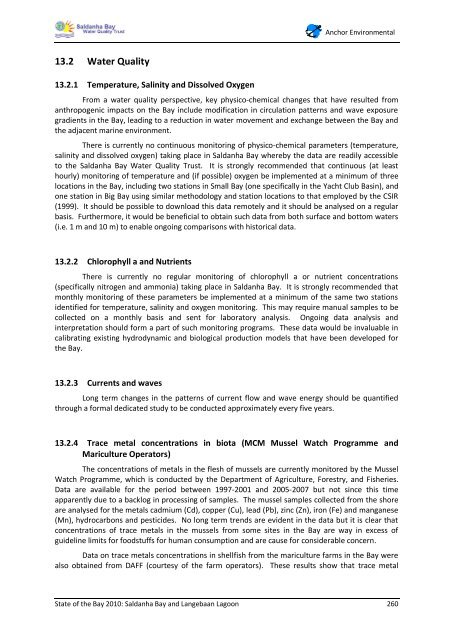State of the Bay Report 2010-Final - Anchor Environmental
State of the Bay Report 2010-Final - Anchor Environmental
State of the Bay Report 2010-Final - Anchor Environmental
You also want an ePaper? Increase the reach of your titles
YUMPU automatically turns print PDFs into web optimized ePapers that Google loves.
13.2 Water Quality<br />
13.2.1 Temperature, Salinity and Dissolved Oxygen<br />
<strong>Anchor</strong> <strong>Environmental</strong><br />
From a water quality perspective, key physico-chemical changes that have resulted from<br />
anthropogenic impacts on <strong>the</strong> <strong>Bay</strong> include modification in circulation patterns and wave exposure<br />
gradients in <strong>the</strong> <strong>Bay</strong>, leading to a reduction in water movement and exchange between <strong>the</strong> <strong>Bay</strong> and<br />
<strong>the</strong> adjacent marine environment.<br />
There is currently no continuous monitoring <strong>of</strong> physico-chemical parameters (temperature,<br />
salinity and dissolved oxygen) taking place in Saldanha <strong>Bay</strong> whereby <strong>the</strong> data are readily accessible<br />
to <strong>the</strong> Saldanha <strong>Bay</strong> Water Quality Trust. It is strongly recommended that continuous (at least<br />
hourly) monitoring <strong>of</strong> temperature and (if possible) oxygen be implemented at a minimum <strong>of</strong> three<br />
locations in <strong>the</strong> <strong>Bay</strong>, including two stations in Small <strong>Bay</strong> (one specifically in <strong>the</strong> Yacht Club Basin), and<br />
one station in Big <strong>Bay</strong> using similar methodology and station locations to that employed by <strong>the</strong> CSIR<br />
(1999). It should be possible to download this data remotely and it should be analysed on a regular<br />
basis. Fur<strong>the</strong>rmore, it would be beneficial to obtain such data from both surface and bottom waters<br />
(i.e. 1 m and 10 m) to enable ongoing comparisons with historical data.<br />
13.2.2 Chlorophyll a and Nutrients<br />
There is currently no regular monitoring <strong>of</strong> chlorophyll a or nutrient concentrations<br />
(specifically nitrogen and ammonia) taking place in Saldanha <strong>Bay</strong>. It is strongly recommended that<br />
monthly monitoring <strong>of</strong> <strong>the</strong>se parameters be implemented at a minimum <strong>of</strong> <strong>the</strong> same two stations<br />
identified for temperature, salinity and oxygen monitoring. This may require manual samples to be<br />
collected on a monthly basis and sent for laboratory analysis. Ongoing data analysis and<br />
interpretation should form a part <strong>of</strong> such monitoring programs. These data would be invaluable in<br />
calibrating existing hydrodynamic and biological production models that have been developed for<br />
<strong>the</strong> <strong>Bay</strong>.<br />
13.2.3 Currents and waves<br />
Long term changes in <strong>the</strong> patterns <strong>of</strong> current flow and wave energy should be quantified<br />
through a formal dedicated study to be conducted approximately every five years.<br />
13.2.4 Trace metal concentrations in biota (MCM Mussel Watch Programme and<br />
Mariculture Operators)<br />
The concentrations <strong>of</strong> metals in <strong>the</strong> flesh <strong>of</strong> mussels are currently monitored by <strong>the</strong> Mussel<br />
Watch Programme, which is conducted by <strong>the</strong> Department <strong>of</strong> Agriculture, Forestry, and Fisheries.<br />
Data are available for <strong>the</strong> period between 1997-2001 and 2005-2007 but not since this time<br />
apparently due to a backlog in processing <strong>of</strong> samples. The mussel samples collected from <strong>the</strong> shore<br />
are analysed for <strong>the</strong> metals cadmium (Cd), copper (Cu), lead (Pb), zinc (Zn), iron (Fe) and manganese<br />
(Mn), hydrocarbons and pesticides. No long term trends are evident in <strong>the</strong> data but it is clear that<br />
concentrations <strong>of</strong> trace metals in <strong>the</strong> mussels from some sites in <strong>the</strong> <strong>Bay</strong> are way in excess <strong>of</strong><br />
guideline limits for foodstuffs for human consumption and are cause for considerable concern.<br />
Data on trace metals concentrations in shellfish from <strong>the</strong> mariculture farms in <strong>the</strong> <strong>Bay</strong> were<br />
also obtained from DAFF (courtesy <strong>of</strong> <strong>the</strong> farm operators). These results show that trace metal<br />
<strong>State</strong> <strong>of</strong> <strong>the</strong> <strong>Bay</strong> <strong>2010</strong>: Saldanha <strong>Bay</strong> and Langebaan Lagoon 260

















